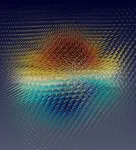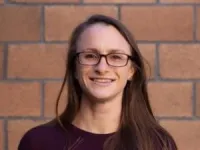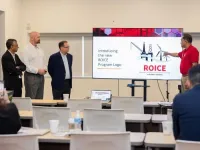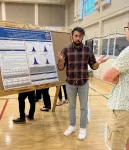(Press-News.org) Metal-halide perovskites have quickly advanced in the last decade since their discovery as a semiconductor that outshines silicon in its conversion of light into electric current.
Simulations on TACC's Frontera and Lonestar6 supercomputers have revealed surprising vortex structures in quasiparticles of electrons and atoms, called polarons, which contribute to generating electricity from sunlight.
This new discovery can help scientists develop new solar cells and LED lighting. This type of lighting is hailed as eco-friendly, sustainable technology that can reshape the future of illumination.
“We found that electrons form localized, narrow wave packets, which are known as polarons. These ‘lumps of charge’ — the quasiparticle polarons — endow perovskites with peculiar properties,” said Feliciano Giustino, professor of Physics and W. A. ‘Tex’ Moncrief, Jr. Chair of Quantum Materials Engineering at the College of Natural Sciences and core faculty at the Oden Institute for Computational Engineering and Sciences (Oden Institute) at UT Austin.
Giustino is a co-author of research on polarons discovered in halide perovskites published March 2024 in the Proceeding of the National Academy of Sciences.
“These polarons show very intriguing patterns. The atoms rotate around the electron and form vortices that had never been observed before,” said Giustino, who also is the director of the Center for Quantum Materials Engineering at the Oden Institute.
The vortex structures of polarons may help the electrons remain being in an excited state, which happens when a photon of light knocks into the compounds at the atomic level.
“We suspect that this strange vortex structure prevents the electron from going back to the unexcited energy level," Giustino explained. "This vortex is a protected topological structure in the halide perovskite lattice material that remains in place for a long time and allows the electrons to flow without losing energy."
Perovskite structures are a type of material known for over a century when Gustav Rose discovered the calcium titanium oxide perovskite CaTiO3 in 1839. More recently, in 2012 Giustino was working with the group of Oxford University scientist Henry Snaith who discovered a new type of perovskite called halide perovskites — where instead of oxygen there are halogens, elements that form salts when they react with metals.
“It turns out that halide perovskites in solar cells show exceptional energy conversion efficiency,” Giustino said.
In comparison, the top efficiency in silicon is about 25 percent, meaning that out of all the energy coming from the sun, one quarter is converted to electricity. To reach 25 percent efficiency, silicon took about 70 years of development. Halide perovskites, on the other hand, managed to reach 25 percent efficiency within just 10 years.
“This is a revolutionary material," Giustino said. "That explains why many research groups working on photovoltaics have moved to perovskites, because they are very promising. Our contribution looked at the fundamentals using computational methods to delve into the properties of these compounds at the level of individual atoms."
For the study, Giustino used allocations on the Lonestar6 and Frontera supercomputers awarded by the Texas Advanced Computing Center (TACC), as well as U.S. Department of Energy (DOE) supercomputers at the National Energy Research Scientific Computing Center (NERSC).
“This research is part of a project sponsored by the Department of Energy that has been going on for several years with the support of TACC and in particular Frontera, where we developed methodologies to study how electrons interact with the underlying atomic lattice,” Giustino said.
For example, Giustino said in the case of halide perovskites, the large polarons they found required simulation cells of about half a million atoms, which is not possible to study with standard methods.
To manage these calculations on a supercomputer, Giustino and his collaborators at Austin and beyond developed EPW, an open-source Fortran and message passing interface code that calculates properties related to electron-phonon interaction. The EPW code specializes in studying how electrons interact with vibrations in the lattice of a solid, which causes the formation of polarons. This code is currently developed by an international collaboration led by Giustino.
“Our collaboration with TACC is more than using advanced computing resources," Giustino said. "The most important part is the interaction with the people. They've been essential in helping us profile the code and making sure we avoid bottlenecks by applying profiling tools that help us study performance decreases. Much of the work happening on the EPW code is in collaboration with TACC experts that help us improve scaling the code to get optimal performance on the supercomputers."
Giustino’s polaron research has been selected as part of TACC’s Characteristic Science Applications (CSA) program funded by the National Science Foundation (NSF). About a dozen CSA projects will inform the design of the next NSF Leadership-Class Computing Facility, called Horizon, under development at TACC.
“The CSA work between my group and TACC to optimize the EPW code allows us to push the frontiers of what one can investigate in understanding and discovering new, important materials. It's a combination of theory, algorithms, and high performance computing with much back and forth with our colleagues at TACC to make sure that we use the supercomputers in the most viable way possible,” Giustino said.
Another possible application is the development of ferroelectric memory devices, computer memory that can be more compact. In it, information is encoded by the vibration of atoms in a crystal under an applied electric field.
“Investment in high performance computing and future computing is essential to science," Giustino concluded. "It requires large investments like the ones that sustain and expand facilities like TACC.”
The study, “Topological polarons in halide perovskites,” was published March 2024 in the Proceedings of the National Academy of Sciences. The authors are Jon Lafuente-Bartolome, Chao Lian, and Feliciano Giustino of the Oden Institute for Computational Engineering and Sciences and the Department of Physics, College of Natural Sciences, UT Austin.
This study was supported by the Computational Materials Sciences Program funded by the U.S. Department of Energy, Office of Science, Basic Energy Sciences, under Award No. DE-SC0020129. In addition to TACC, this work used resources of the National Energy Research Scientific Computing Center, a Department of Energy Office of Science User Facility supported by the Office of Science of the U.S. Department of Energy under Contract No. DE-AC02-05CH11231.
END
Surprising vortex behind new solar cell and lighting materials
TACC Frontera, Lonestar6 supercomputer simulations reveal topological vortices in polaron quasiparticles
2024-06-25
ELSE PRESS RELEASES FROM THIS DATE:
Should you eat more dietary fiber? New study says it depends.
2024-06-25
ITHACA, N.Y. -- Nutritionists generally advise everyone to eat more dietary fiber, but a new Cornell University study suggests that its effects on health can vary from person to person. The findings indicate that recommendations should be tailored to each individual’s gut microbiome.
The study, published in Gut Microbes, focused on resistant starch, a category of dietary fiber found in such foods as bread, cereals, green bananas, whole-grain pasta, brown rice and potatoes.
The researchers identified ...
Researchers evaluate the benefit of dual therapy for children at risk for spinal muscular atrophy
2024-06-25
In a first-of-its-kind study, researchers compared the efficacy of preventative therapy for spinal muscular atrophy (SMA) between two well-matched study groups, using either gene therapy (onasemnogene abeparvovec) alone or in combination with risdiplam (oral medication) or nusinersen (intrathecal injection) administered before apparent signs of disease emerged. The study included presymptomatic infants with two or three copies of SMN2 at risk for developing SMA type 1 or 2, respectively. SMA is a devastating ...
Analysis suggests 2021 Texas abortion ban resulted in increase in infant deaths in state in year after law went into effect
2024-06-25
A study led by Johns Hopkins Bloomberg School of Public Health researchers estimates that infant deaths in Texas increased more than expected in the year following the state’s 2021 ban on abortion in early pregnancy, especially among infants with congenital anomalies.
The Texas law prohibiting abortions after a fetal heartbeat could be detected—as early as five or six weeks—went into effect September 1, 2021. At the time, the law—Senate Bill 8, or S.B. 8—was the most stringent state abortion law in the country. It did not allow exemptions for congenital ...
Large integrative medicine center implements processes to measure and understand clinical effectiveness
2024-06-25
CLEVELAND - Led by a team of researchers at University Hospitals Connor Whole Health, a new study finds that collecting paper-based patient-reported outcome (PRO) measures of pain, anxiety, and stress is feasible – and that provider, operational, and clinical-level factors impact successful completion more so than patient factors.
Patients often seek integrative health and medicine (IHM) modalities such as acupuncture, chiropractic, and massage in the outpatient setting, most commonly for concerns of pain, anxiety, and stress. In contrast to ...
Empathetic children may have poorer health in the face of interparental conflict
2024-06-25
UNIVERSITY PARK, Pa. — Children who report being more empathetic are more likely to show signs of poorer health in the face of more interparental conflict than less empathetic children, according to a new study led by researchers in the Penn State College of Health and Human Development.
The study, led by Hannah Schreier, associate professor of biobehavioral health and co-funded faculty member in the Social Science Research Institute, was recently published in the journal Brain, Behavior, and Immunity.
“For children this age, 7 to 9 years old, the family home and parents are important, so observing conflict ...
Marsquakes may help reveal whether liquid water exists underground on red planet
2024-06-25
UNIVERSITY PARK, Pa. — If liquid water exists today on Mars, it may be too deep underground to detect with traditional methods used on Earth. But listening to earthquakes that occur on Mars — or marsquakes — could offer a new tool in the search, according to a team led by Penn State scientists.
When quakes rumble and move through aquifers deep underground, they produce electromagnetic signals. The researchers reported in the journal JGR Planets how those signals, if also produced on Mars, could identify water miles under the surface. The study may lay the groundwork for future analyses of data from Mars missions, according to ...
Unexpected diversity of light-sensing proteins goes beyond vision in frogs
2024-06-25
UNIVERSITY PARK, Pa. — Frogs have maintained a surprising diversity of light-sensing proteins over evolutionary time, according to a new study led by a Penn State researcher. Light-sensing proteins, called opsins, enable vision in sighted animals, and are responsible for many more biological functions like regulating circadian rhythms. The researchers explored the evolution of nonvisual opsins in frogs, finding that most modern species examined in this study retained a shocking number of these proteins.
The findings were published in the June issue of the journal Molecular ...
University of Houston strengthens commitment to clean energy with key partnerships
2024-06-25
HOUSTON, June 25, 2024 - The University of Houston, the energy university with multiple energy-focused research centers, last week signed two memorandums of understanding with industry partners Promethean Energy and Endeavor Management. The agreements formalize the partnership to address the challenges of repurposing offshore infrastructure for clean energy use.
Both companies will work closely with UH Energy, the University’s interdisciplinary energy initiative, and members of UH’s Repurposing Offshore Infrastructure for Clean ...
UT Arlington prioritizes undergraduate research to ensure student success
2024-06-25
Studies have shown that undergraduate students who participate in research activities under the guidance of a faculty member or mentor are more likely to finish college. That’s one of the reasons why The University of Texas at Arlington has tripled its investment in specific undergraduate research opportunities.
“Engaging students in original scholarship is time-intensive and expensive, but the outcomes are overwhelmingly positive, leading to more student success and an increase in the number of students interested in pursuing graduate school, including medical school,” said Kayunta Johnson-Winters, interim director of undergraduate research at UTA and an associate ...
Researchers identify a novel biomarker linked to renal cancer recurrence
2024-06-25
Researchers from the University of Michigan Health Rogel Cancer Center have discovered a biomarker that could help identify which renal cancer patients have a higher risk of recurrence.
The findings were published in JCO Precision Oncology.
Kidney cancer accounts for about 3-5% of all cancers; clear cell renal cancer makes up about 75% of all kinds of kidney cancers. Currently, treatment for clear cell renal cancer is determined based on the size and grade of the tumor and stage of overall disease.
But this “one-size-fits-all” approach isn’t always precise.
“We ...
LAST 30 PRESS RELEASES:
The Ceramic Society of Japan’s Oxoate Ceramics Research Association launches new international book project
Heart-brain connection: international study reveals the role of the vagus nerve in keeping the heart young
Researchers identify Rb1 as a predictive biomarker for a new therapeutic strategy in some breast cancers
Survey reveals ethical gaps slowing AI adoption in pediatric surgery
Stimulant ADHD medications work differently than thought
AI overestimates how smart people are, according to HSE economists
HSE researchers create genome-wide map of quadruplexes
Scientists boost cell "powerhouses" to burn more calories
Automatic label checking: The missing step in making reliable medical AI
Low daily alcohol intake linked to 50% heightened mouth cancer risk in India
American Meteorological Society announces Rick Spinrad as 2026 President-Elect
Biomass-based carbon capture spotlighted in newly released global climate webinar recording
Illuminating invisible nano pollutants: advanced bioimaging tracks the full journey of emerging nanoscale contaminants in living systems
How does age affect recovery from spinal cord injury?
Novel AI tool offers prognosis for patients with head and neck cancer
Fathers’ microplastic exposure tied to their children’s metabolic problems
Research validates laboratory model for studying high-grade serous ovarian cancer
SIR 2026 delivers transformative breakthroughs in minimally invasive medicine to improve patient care
Stem Cell Reports most downloaded papers of 2025 highlight the breadth and impact of stem cell research
Oxford-led study estimates NHS spends around 3% of its primary and secondary care budget on the health impacts of heat and cold in England
A researcher’s long quest leads to a smart composite breakthrough
Urban wild bees act as “microbial sensors” of city health.
New study finds where you live affects recovery after a hip fracture
Forecasting the impact of fully automated vehicle adoption on US road traffic injuries
Alcohol-related hospitalizations from 2016 to 2022
Semaglutide and hospitalizations in patients with obesity and established cardiovascular disease
Researchers ‘listen in’ to embryo-mother interactions during implantation using a culture system replicating the womb lining
How changing your diet could help save the world
How to make AI truly scalable and reliable for real-time traffic assignment?
Beyond fragmented markets: A new framework for efficient and stable ride-pooling
[Press-News.org] Surprising vortex behind new solar cell and lighting materialsTACC Frontera, Lonestar6 supercomputer simulations reveal topological vortices in polaron quasiparticles






